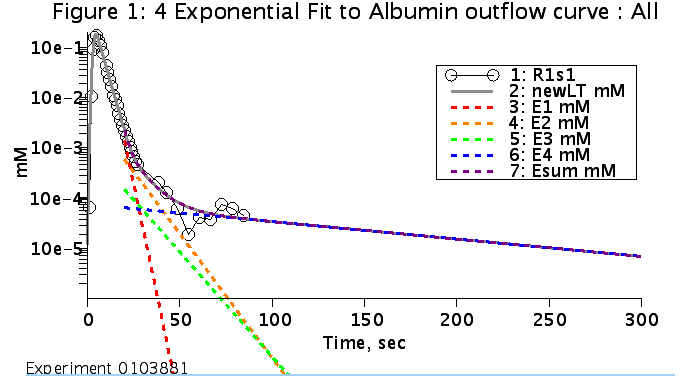Two, three, or four decaying exponentials are used to fit the long tails on indicator dilution curves for vascular tracers, e.g. albumin, by joining a multi-exponential function to a probability density curve representing a bolus injection.
Description
Fit the long tail of a vascular outflow curve from an indicator dilution
curve with the sum of N exponentials at tjoin matching both the function,
F, and the slope, S. N equals 2, 3 or 4. It is assumed that S is negative.
N
-----
\
Tail(t) = ) w(i)*exp( -k(i)*(t-tjoin) )
/
-----
i = 1
where w(i) = a(i)*w(i+1), a(i)>0; k(i)=b(i)*k(i=1), b(i)>1.
F is the value of the function and S is the slope at t=tjoin.
The coefficients are more complicated than in the fractal case (see
LongTailFractal), but reduce to the fractal expressions when the a's
and b's are chosen so tat a1=a2=a3, and b1=b2=b3
It can be shown that
N N
----- -----
\ \
F= ) w(i) and S= ) -w(i)*k(i)
/ /
----- -----
i = 1 i = 1
The user can use optimization to calculate values for the a's,
b's, and tjoin. The restrictions on the a's and b's are all the
the a's are greater than 0; all the b's are greater than 1.

For further information relating PowerLaw scaled models with power law models
Equations
None.
The equations for this model may be viewed by running the JSim model applet and clicking on the Source tab at the bottom left of JSim's Run Time graphical user interface. The equations are written in JSim's Mathematical Modeling Language (MML). See the Introduction to MML and the MML Reference Manual. Additional documentation for MML can be found by using the search option at the Physiome home page.
- Download JSim model MML code (text):
- Download translated SBML version of model (if available):
- No SBML translation currently available.
- Information on SBML conversion in JSim
We welcome comments and feedback for this model. Please use the button below to send comments:
L.M. Schwartz, T.R. Bukowski, J.H. Revkin, and J.B. Bassingthwaighte. Cardiac endothelial transport and metabolism of adenosine and inosine. Am. J. Physiol. 227 (Heart Circ. Physiol. 46):1231-1251, 1999.
Please cite https://www.imagwiki.nibib.nih.gov/physiome in any publication for which this software is used and send one reprint to the address given below:
The National Simulation Resource, Director J. B. Bassingthwaighte, Department of Bioengineering, University of Washington, Seattle WA 98195-5061.
Model development and archiving support at https://www.imagwiki.nibib.nih.gov/physiome provided by the following grants: NIH U01HL122199 Analyzing the Cardiac Power Grid, 09/15/2015 - 05/31/2020, NIH/NIBIB BE08407 Software Integration, JSim and SBW 6/1/09-5/31/13; NIH/NHLBI T15 HL88516-01 Modeling for Heart, Lung and Blood: From Cell to Organ, 4/1/07-3/31/11; NSF BES-0506477 Adaptive Multi-Scale Model Simulation, 8/15/05-7/31/08; NIH/NHLBI R01 HL073598 Core 3: 3D Imaging and Computer Modeling of the Respiratory Tract, 9/1/04-8/31/09; as well as prior support from NIH/NCRR P41 RR01243 Simulation Resource in Circulatory Mass Transport and Exchange, 12/1/1980-11/30/01 and NIH/NIBIB R01 EB001973 JSim: A Simulation Analysis Platform, 3/1/02-2/28/07.

